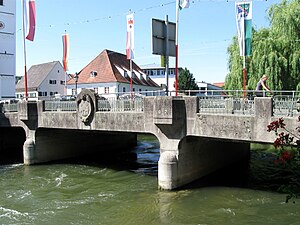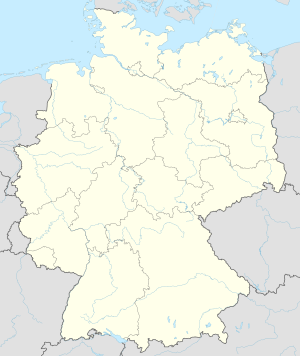Amperbrücke (Fürstenfeldbruck)
Coordinates: 48 ° 10 ′ 37 ″ N , 11 ° 15 ′ 21 ″ E
| Amperbrücke | ||
|---|---|---|
| use |
|
|
| Crossing of | Amperes | |
| construction | Reinforced concrete - plate bridge | |
| completion | 1909 | |
| location | ||
|
|
||
The Amper bridge is built in 1909 a reinforced concrete - slab bridge in Fuerstenfeldbruck . The river crossing is named for the market and the city that developed below the Fürstenfeld monastery . The bridge connects Hauptstrasse and Münchener Strasse, which are located along Bundesstrasse 2 .
Origin and history
A bridge near the parish church of St. Stephan bei Pfaffing is mentioned for the first time in the documents in 1184. The river crossing was used in particular for salt transports between Reichenhall and Augsburg . The customs law , which in addition to the maintenance of the bridge also included the maintenance of the access roads, was initially exercised by the counterpoints . Not only foreigners, but also the residents of the city themselves were subject to duty. Customs rights later passed to the noble family von Pellhiem through marriage and were sold by them to the Fürstenfeld monastery in 1425 due to lack of money. When the monastery was closed in 1803, the bridge became the property of the market town of Fürstenfeldbruck. In 1804 the duty for the bridge was lifted, but the Bruckers took over the obligation to maintain the structure.
Building
Originally a wooden bridge spanned the Amper , but it was regularly damaged by floods and ice falls and therefore had to be constantly repaired. Next to the bridge was a horse pond where farm animals could be washed.
In 1909, the Amperbrücke was rebuilt as a reinforced concrete structure and, in addition to parapets in Art Nouveau style, also contains a sculpture of the bridge saint John of Nepomuk, which was attached to this place in 1924 . Since 1722 there has also been a statue on the old bridge with its image made of copper, which replaced a cross that was previously attached to an engraving by Michael Wening from 1700.
In April 1945 the citizens of Fürstenfeldbruck saved the bridge from destruction by fleeing SS troops.
Planned new building
In April 2014, test bores were carried out by the road construction authority to examine the building site for a new construction of the Amperbrücke, which would replace the structure from 1909. As a result, the bridge could also be released for vehicles with a total weight of more than 16 tons. There is resistance to the plans from the residents of the city, who fear that the bridge could also be used by 40 ton trucks , and who point out the monumental value of the building.
Web links
Individual evidence
- ^ Website of the city of Fürstenfeldbruck
- ↑ The bridge that gave Bruck its name has existed since 1184. merkur-online.de, accessed on May 11, 2014 .
- ^ Website of the historical Fürstenfeldbruck association
- ^ Report in the Süddeutsche Zeitung


